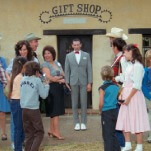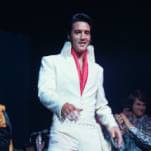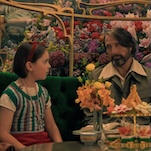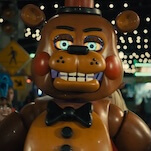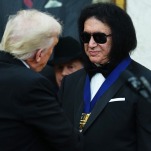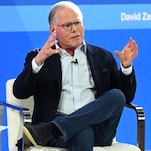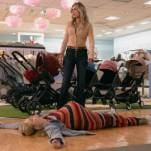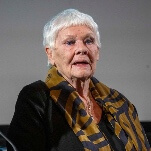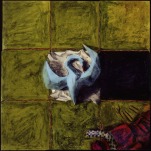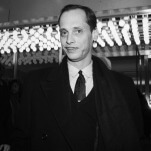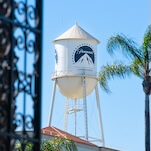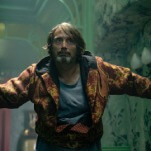Jerry Springer invented the present
For most of the history of television, the barrier to syndication—and to profitability—has been 100 episodes. The shows that have made it to that mark are an unusual group. Many were big hits. Some found small cult audiences. Still others just hung on as best they could and never posted numbers quite low enough to be canceled. In 100 Episodes, we examine the shows that made it to that number, considering both how they advanced or reflected the medium and what contributed to their popularity.
WARNING: This ill-advised attempt to reconsider The Jerry Springer Show’s critical reputation may contain adult themes or strong language. Parents are cautioned that this article may not be suitable for anyone.
The man should not command much adoration. He’s quiet and unassuming. Truth be told, he looks like a bit of a nerd, the kind of guy who might be a divorce lawyer or anchor the evening news. In fact, that’s who he was before this show began: a Cincinnati news anchor acclaimed for his hard-hitting journalism. (Before that, he had briefly been the city’s mayor.) He didn’t want to be here, listening to the gathered throngs chant his name in this television coliseum. The show he had signed on to host was an extension of his journalism career, a serious-minded look at issues of importance that wouldn’t have been out of place next to the Phil Donahues of the world. Yet ratings pressures will push just about anyone into a corner in television, and here he was, no longer exposing America’s dark underbelly but rolling around in it. Hadn’t he harbored political aspirations once? And on and on cheered the masses: “JERRY! JERRY! JERRY! JERRY!” He might not have known it at the time—he might have given interviews in which he decried the show that brought him to prominence—but Jerry Springer was inventing the present.
Yes, it sounds ridiculous. The Jerry Springer Show was exploitative trash, not a show that anticipated the world of today. But watch a late-’90s episode of the talk show through the prism of the world we live in today. Springer was YouTube before YouTube, widespread Internet fetish porn before widespread Internet fetish porn, reality TV before reality TV. It was indebted to the past, particularly to programs like Donahue and The Morton Downey Jr. Show. Hell, the show’s trajectory can be directly tied to the rise of The Ricki Lake Show, a program it would overtake and eventually outlive. But Springer gobbled up those shows whole, synthesized them into its DNA, then turned itself up to 11. It was no longer a television show. It was America’s id, going nuts on stage, and the man who presided over it looked like a math teacher.
The 34th rule of the Internet—as determined by members of the group Anonymous for the site 4chan in the mid-’00s—is “There is porn of it. No exceptions.” The idea is a celebration of the Internet’s massive democratization and of the belief that humans will get off to just about anything. Name the item, and there’s a site dedicated to that specific fetish or peccadillo. There are a lot of reasons for this, chief among them the fact that kids who grew up with the Internet increasingly turned to it for their porn-related needs. But it’s not as if Internet porn arrived fully formed and ready to serve any possible constituency. Yes, the integration of the net into American homes meant that it would surely be used for pornography—most technological advances are eventually. But there had to be an evolutionary step between the idea of Internet porn targeted at just about any possible fetish community (which was often greeted with horrified shock in the ’90s) and a world where the idea of this existing is mostly greeted with an acknowledgement that it’s out there and is probably best left out of polite conversation, all things considered.
That evolutionary step was The Jerry Springer Show.
Almost everything about the sexual politics of The Jerry Springer Show was deeply horrifying, as it presented almost anything that deviated from the typical monogamous norm as a strange, seedy horror. (Weirdly, the show was fairly progressive when it came to gays and lesbians—even if it boasts episodes with titles like “Lesborama!”) Springer himself leaned socially liberal, but he knew that presenting deviations from the norm would require a kind of shocked sternness. He was the high school principal who found kids having sex in the bathroom during class, and he was not happy about it.
Yet the savvy of Springer—and what so many of his imitators missed—was that The Jerry Springer Show treated almost all of this with equal titillation. Take, for instance, the show’s treatment of transgender people, notably trans women, one of the first arenas the show explored when making its shift from a more straightforward talk show to what it became. Springer was hardly the first talk show to tackle the subject, which was a talk show mainstay, and no one should suggest Springer was a bastion of progressive thinking when it came to trans issues. Trans people were treated just like everybody else—which was to be used for the purpose of Springer’s usual freak show format. But the show, and these women, also dared viewers to find the idea a little alluring. That idea was surprisingly revolutionary. Sure, objectification is just another form of making someone “the other,” but it was a damn sight better than the demonization most other talk shows practiced. And the longer the show ran on, the more that attitude spread to other American subcultures.
Of course, the titillation was only implied. The show sat in judgment, mostly, the freak show narrative inviting the audience to sit in superiority over the guests and cackle at the weirdos. But that’s ignoring all of the people the show admitted the simple existence of. It featured people engaged in incestuous relationships. It featured dominant/submissive affairs and polygamists. In the show’s most controversial episode, it featured a man married to a horse. Springer never normalized any of this, because the freaks always needed to be laughed at. But by simply allowing all of these people onto television—even if they were there to slot into certain pre-formed narratives—the series casually opened the door to a nation that was not as white bread as it desperately insisted it was. Jerry Springer guests were everywhere. Maybe you were one, late at night, when you couldn’t get your brain to shut up.







